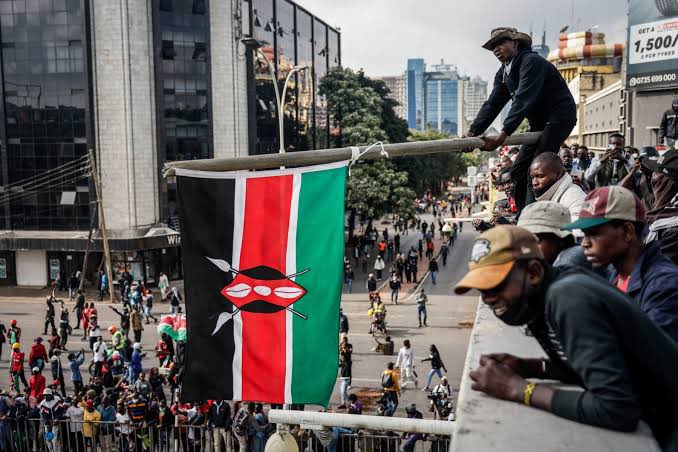One year after a deadly wave of youth-led protests gripped Kenya, the streets of Nairobi and other cities are once again flooded with defiant chants, mass demonstrations, and the determined spirit of a new generation. Branded the “Gen Z Revolt,” this movement has re-emerged with fresh urgency and a singular, powerful demand: “Ruto Must Go.”
What started as a commemoration for those killed in last year’s protests has evolved into a national reckoning. Frustrated by economic hardship, police brutality, and unfulfilled promises, Kenya’s youth—mostly late millennials and Gen Zs—are rising again, and this time they’re not just marching against tax hikes—they’re calling for systemic change.
What Sparked the 2025 Protests?
The current protests began as a peaceful “Anniversary March” to honor the dozens of youth killed during the June 2024 anti-tax protests, in which demonstrators stormed Kenya’s parliament to denounce a widely unpopular finance bill.
That law, pushed by President William Ruto, would have dramatically raised taxes amid rising unemployment and inflation. The backlash was immediate and furious.
Over the course of several days, more than 60 protesters were killed, and at least 20 went missing in what many human rights groups described as a state-led crackdown.
President Ruto eventually withdrew the tax bill and promised reform, including efforts to end police brutality and the symbolic inclusion of opposition voices in his cabinet. But many viewed these as superficial concessions, not real change.
Why Are Protests Reigniting Now?
In the year since the government’s promises, conditions have worsened.
- Youth unemployment has soared.
- Police violence has intensified.
- The economy has faltered, with inflation and debt rising.
These deepening crises have reignited public anger, but it was the death of blogger and teacher Albert Ojwang that truly reignited the fire.
Ojwang, 31, was arrested for criticizing a senior police officer on social media. He later died from injuries allegedly sustained while in police custody. Public backlash exploded after his death, and though six officers were charged, many viewed it as a symbolic gesture to placate outrage, not a genuine pursuit of justice.
When demonstrators gathered to protest Ojwang’s killing, police opened fire. Among the casualties was Boniface Kariuki, a street vendor struck by a bullet. His death further inflamed public anger and drove more young people into the streets.
The Government’s Response
The Kenyan government has responded with militarized policing, mass arrests, and no willingness to compromise. Major intersections in Nairobi are now cordoned off, and security forces have been deployed to control the protests.
The administration’s firm refusal to entertain the main demand—President Ruto’s resignation— has only galvanized protesters further.
Critics say Ruto is exhibiting the authoritarian tendencies of the so-called “sit-tight syndrome” common among African leaders. His refusal to step down or engage with protesters has turned the demonstrations from a civil plea into a revolutionary stand.
What the Protesters Want
While last year’s protests were sparked by a tax bill, this year’s uprising is driven by something deeper: a demand for accountability, dignity, and genuine leadership.
The youth have one central demand:
“Ruto Must Go.”
This demand isn’t just political. It’s personal, emotional, and rooted in years of broken promises, unlivable economic conditions, and fatal state violence.
What’s Next for Kenya?
The current protests represent more than a fight over policies—they reflect a generational crisis of trust in government institutions. Young Kenyans have grown up amid inequality, corruption, and economic stagnation. They are more digitally connected, politically conscious, and globally aware than previous generations.
This uprising is not an isolated event but part of a growing wave of youth-led movements across Africa, from Sudan to Nigeria, where social media-savvy protesters are organizing against entrenched political elites.
As international observers monitor Kenya’s volatile situation, questions linger:
- Will the government escalate its response?
- Can President Ruto survive the political fallout?
- And will the youth-led demand for change lead to lasting reform—or deeper unrest?
Global Reactions
Human rights groups and diaspora communities have expressed support for the protesters. The #RutoMustGo hashtag is trending globally, and international pressure is mounting on the Kenyan government to exercise restraint and initiate meaningful dialogue.
📝 Key Takeaways:
- Kenya is facing a renewed wave of youth-led protests branded as the “Gen Z Revolt.”
- Demonstrators are demanding President William Ruto’s resignation.
- The movement was reignited by police brutality and worsening economic conditions.
- Deaths of innocent citizens like Albert Ojwang and Boniface Kariuki have radicalized the movement.
- The protests have shifted from anti-tax demonstrations to a full-fledged demand for government accountability and justice.
As Kenya’s youth chant, organize, and occupy the streets once again, the world watches—not just with concern, but with admiration for their courage. Whether this revolution results in real change remains to be seen. But one thing is certain: Kenya’s youth are no longer silent—and they won’t be easily silenced again.
